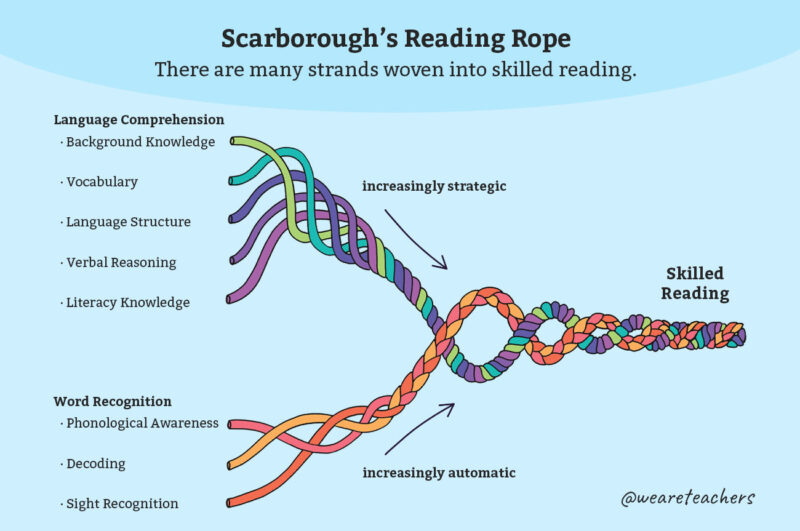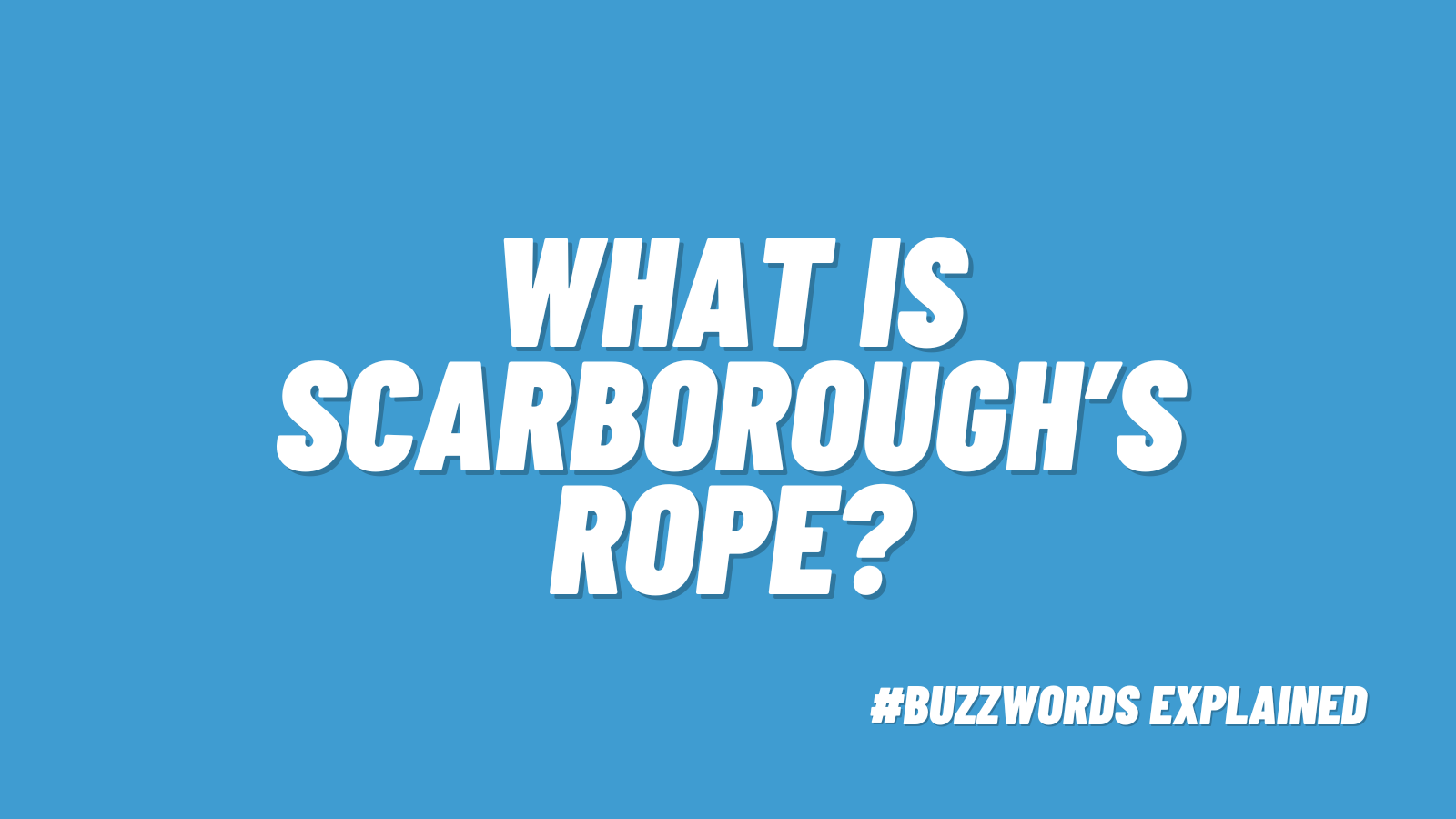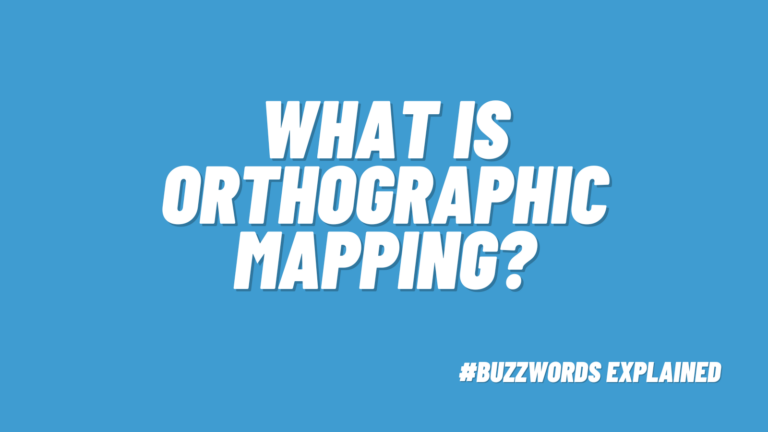Experienced teachers know that true literacy is much more than just being able to sound out the letters on the page. Skilled readers need to be able to master both what the words are and what they mean. To do this successfully, they bring together various skills like vocabulary, language structure, and verbal reasoning. Scarborough’s Reading Rope is one well-known model that can help educators better understand what it truly takes to create skilled readers.
What is Scarborough’s Reading Rope?

Dr. Hollis Scarborough invented the concept of the Reading Rope in the early 1990s. She used it to help parents understand the various skills their children needed to master to become proficient readers. Originally, she twisted together a model made of pipe cleaners to demonstrate her point.
In 2001, the model was published in the Handbook of Early Literacy Research (Neuman/Dickinson). Reading teachers immediately saw how useful it was, and it became a staple for educating new teachers and parents alike.
Scarborough’s Reading Rope contains two main sections: Word Recognition and Language Comprehension. Each of these comprises several smaller strands. Woven together, these strands become the rope that represents complete skilled reading. All the components are interconnected and interdependent. If just one strand is weak, it affects the rope (and the reader) as a whole.
Lower Section: Word Recognition
The lower section of Scarborough’s Reading Rope focuses on word recognition skills. These are the skills we tend to think of first when we talk about teaching kids how to read. Imagine a kid sounding out the letters on a page or putting together phonics sounds and syllables. These are the basics of word recognition.
Phonological Awareness
Put simply, phonological awareness is about understanding that spoken words are made up of sounds. Kids learn to speak without ever needing to see a written word. But when they learn reading, they need to recognize that the sounds they make with their mouths correspond with the words they see on the page. Phonological awareness is the ability to hear and work with spoken sounds that sets the stage for reading and writing.
Decoding
Decoding is what we picture when we think of beginning readers: kids using the sounds of letters to read words. As kids get better at decoding, they use their understanding of phonics patterns like blends, digraphs, silent letters, and vowel teams to read words. Kids proficient at decoding can efficiently “sound out” all the unfamiliar words they see on a page, even if they don’t know what the words mean.
Sight Words
Orthographic mapping—the brain’s process for recognizing and permanently storing words—allows readers to build a rapidly growing bank of “sight words,” or words they recognize automatically without having to decode them. It’s generally accepted that directly teaching kids some of the most common sight words as early readers, especially ones that use phonics patterns they haven’t learned yet, gives them a leg up when learning to read.
Upper Section: Language Comprehension
Word recognition on its own doesn’t create fluent readers. If kids don’t know what the words themselves mean, they’re not really reading. Fluent readers understand the text they’re reading as a whole, drawing meaningful conclusions and finding important takeaways. The upper strands of Scarborough’s Reading Rope are incredibly key in creating strong readers.
Background Knowledge
Background knowledge, or everything a reader already knows, impacts their understanding of what they read. Kids reading a novel set in World War II Germany will get a lot more out of it when they understand more about WWII in general. For teachers, this means placing reading choices in context across the entire curriculum. Use reading (at any age) as part of a larger lesson on any topic. Kids will develop a deeper understanding and improve literacy skills at the same time.
Vocabulary
Building a rich vocabulary means kids can enjoy reading a wider variety of books. When you have to stop every few sentences to figure out what a word means, you’re likely to give up on reading a lot faster. Even worse is when kids don’t stop, since they’ll have “read” something without understanding it fully—or at all. Vocabulary development happens both orally and in reading. The best vocabulary teaching both boosts the number of words kids know and how well they know those meanings—for instance, understanding how a word like “curious” can be used in different contexts to mean inquisitive or peculiar.
Language Structure
When we talk about language structure, we generally mean syntax (the order of words) and semantics (the meaning of the text). English has a lot of rules for the patterns and order of words, known as syntax. Semantics delves deep into how words and phrases combine to create meaning and how an author’s word choice affects that meaning. It’s a complicated topic, which good readers continue to consider throughout their lives.
Verbal Reasoning
When it comes to Scarborough’s Reading Rope, verbal reasoning refers to understanding the variety of ways words can be used literally and figuratively. It includes things like metaphors, analogies, idioms, and figurative language. Kids pick up some of these things as they grow, but classroom instruction can be helpful too.
Literacy Knowledge
Kids gain literacy knowledge by exposure to a wide array of literary genres and styles. This is why a strong curriculum covers fiction, nonfiction, and poetry in all their forms. Generally speaking, the more types of reading a child encounters, the more advanced their literacy knowledge becomes.
How can teachers use Scarborough’s Rope?
Many teachers find Scarborough’s Reading Rope useful in two main ways. First, it helps teachers look at the big picture of their literacy curriculum to make sure they’re providing kids with instruction in all the necessary areas. This big-picture understanding can also help teachers identify where struggling readers may need more help. For instance, a student may be very good at sounding out the words on the page but lack the vocabulary or verbal reasoning to make sense of what they’re reading. Once they identify the weak strands, a teacher can make adjustments or offer enrichment to help that student succeed.
Second, teachers can (and should) share this model with parents. It can help them understand that while reading is about “sounding out the words,” it’s also about lots more. It can explain where their child is struggling or why teachers use such a variety of methods in the classroom. It’s also a good tool to reinforce that reading at home is essential to building the literacy skills kids need in school and throughout their lives.

